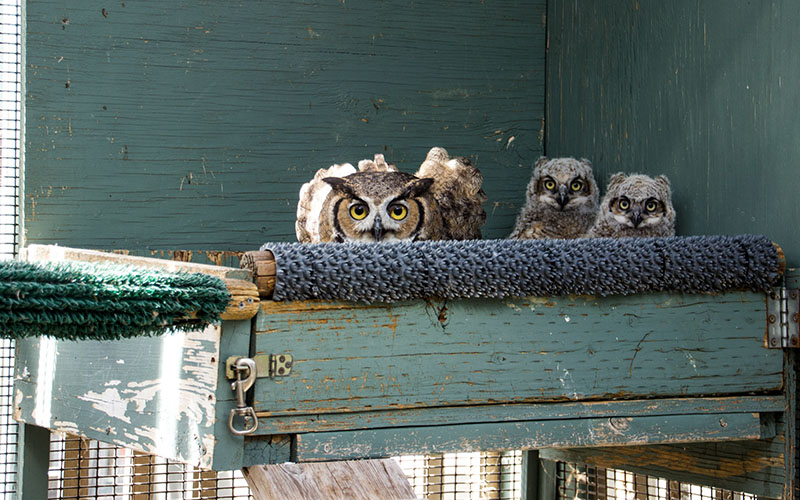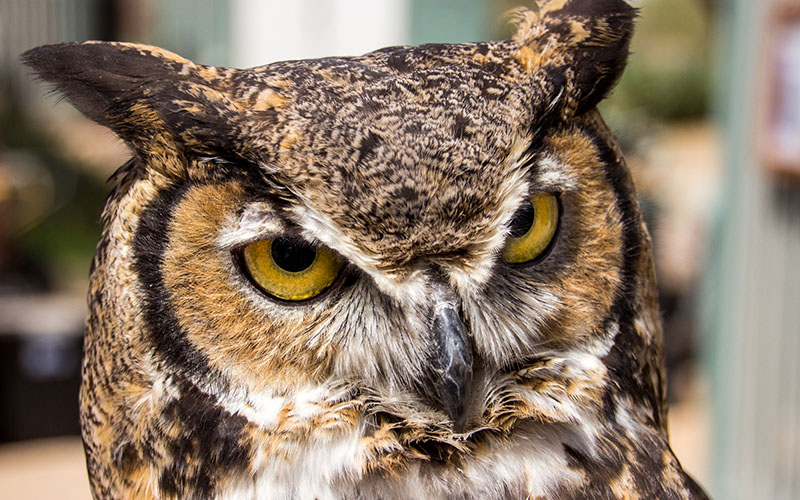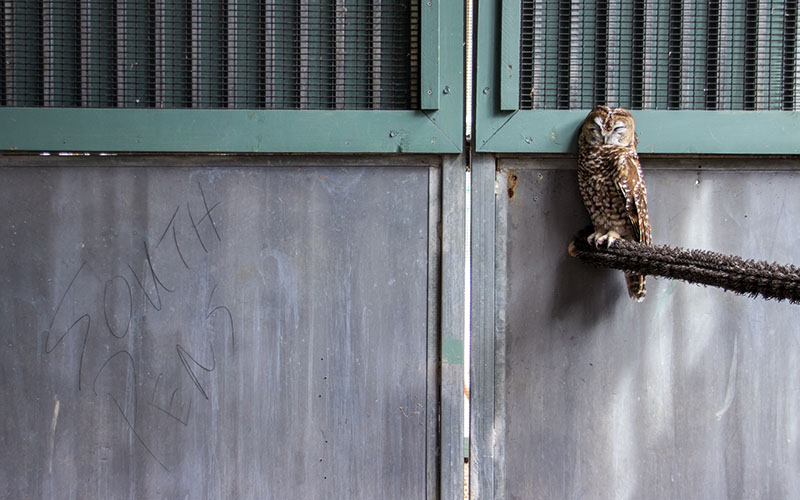
Scheherazade, a great horned owl, lives at Wild at Heart, a rescue organization for raptors in Cave Creek. She also fosters owlets in need, including these two. (Photo by Gabriel Sandler/Cronkite News)

Owls are slow to show symptoms of poisoning, and by the time they do, treatment rarely works, wildlife experts say. (Photo by Gabriel Sandler/Cronkite News)

A spotted owl rests in an aviary at Wild at Heart, a raptor rescue service in Cave Creek. Although great horned owls are the most affected, experts said every raptor species is vulnerable to accidental rodenticide poisoning. (Photo by Gabriel Sandler/Cronkite News)
CAVE CREEK – Great horned owls, one of the most common raptors in the United States, are being threatened by rat poison in their prey.
Since 2011, the Arizona Game & Fish Department has identified 50 cases of wildlife poisoning from pest control chemicals. Forty one of those involved anticoagulant rodenticide.

Bob Fox founded Wild at Heart, a raptor recovery center in Cave Creek, in 1990. When a bird comes in because of poisoning, he says, staff members usually can offer comfort, not treatment. (Photo by Gabriel Sandler/Cronkite News)
From cities in Massachusetts to rural agricultural hubs in California, great horned owls and other wildlife are becoming victims of these poisons, which work their way up the food chain from prey to predator.
Bob Fox, founder of Wild at Heart, a Cave Creek raptor rescue center, remembers checking an old saguaro where a great horned owl and her owlets were nesting. People living nearby had called him, concerned after not seeing the mother in days.
“So I went up, looked in the nest, and I could see the female: She was dead, wings spread,” Fox said. “Picking her up, all three of her young were dead also. All with blood coming out of their feathers from an anticoagulant.”
Fox said he knew immediately that anticoagulant rodenticide was the likely cause of death.
Anticoagulant rodenticide is common, used by both individuals and pest control companies. Despite U.S. Environmental Protection Agency regulations, however, some wildlife advocates and Arizona officials are worried about an increase in accidental wildlife poisoning.
Across the country, the great horned owl is an example.
“Great horned owls produce two to three offspring a year,” Fox said. “You’re talking about a huge impact in the number of rodents that all the birds of prey will consume. They’re a really valuable asset to our ecology.”
When rodenticide is introduced to the food chain, “You can kill an entire families of owls,” Fox said.
“Basically, sometimes what we (Wild at Heart workers) are here for is like a halfway house; it’s a place where an animal can come and die peacefully.”
Poisoning is difficult to treat. It takes time for the owls to show symptoms, and by the time they do, treatment rarely works. This can be true for other animals as well, including hawks, eagles, raccoons and coyotes.
“You put rodenticides out, a rat eats it, (the rat) gets out,” Fox said. “It takes several days for it to die, it becomes lethargic and easy prey for birds of prey, hawks, owls, or domestic animals, dogs, cats.
“They start to bleed out internally. When we see them, they’re lethargic, their mouths are light and very pale as opposed to the healthy pink, and they just slowly fail and do not survive.”
Anne Justice-Allen is a veterinarian and wildlife health supervisor for Arizona Game & Fish. She performs wildlife necropsies and helps decide when a case needs further testing.

Anne Justice-Allen, a veterinarian and wildlife health specialist for Arizona Game & Fish, has been worried about the number of owls affected by rat poison. Because owls are such superb hunters, their decline only makes rodent problems worse, she says. (Photo by Gabriel Sandler/Cronkite News)
“If we get a great horned owl as a necropsy animal, an animal to autopsy, it is either rodenticide or a viral infection,” Justice-Allen said. “More frequently, it’s actually rodenticide. It’s a really distressing problem for us.”
State data reflect “the tip of the iceberg,” said Justice-Allen, whose department examines the few birds that are brought in, mostly from the Phoenix area. In addition, toxicology reports are expensive and sometimes unnecessary.
“When we get birds that have been poisoned by rodenticide, first of all, we usually have a fairly high index of suspicion. It’s at the top of the list for what we think might be going on,” she said.
Justice-Allen called great horned owls the “best pest control out there,” especially when it comes to urban rodents, such as roof rats. She’s concerned that the federal regulations on rodenticides do not go far enough to protect the owls and other animals.
“EPA says if you’re using certain kinds of rodenticides there’s restrictions on them … to prevent the secondary poisoning and toxicity,” she said. “That doesn’t seem to be going as much as we’d like.”
Fox agreed, acknowledging that with fewer resources, the problem falls to the public.
“It’s a bigger problem than anyone’s really aware of,” Fox said. “They do regulate as much as they can. But again, it’s a staffing issue, even for the state and federal agencies.”
The EPA has restricted some toxins, such as d-CON. Even Maricopa County warns against certain d-CON products, because “If pets or wild birds nibble on a rat killed with d-Con, they can become sick.”
Additionally, some rodenticides are only available to pest control companies, not individual consumers. This prevents overuse of the toxin, or applying it where wildlife would be at risk.
– Cronkite News video by Nicole Randock
In 2008, the EPA published a risk analysis of 10 rodenticides for their impact on humans, pets and wildlife. The EPA is reviewing all rodenticides and re-evaluating their safety, along with examining their ecological impact.
Despite this, wildlife poisonings, especially among predator birds, have persisted. It has been documented in urban areas, including Phoenix, and agricultural areas, such as Napa Valley in California.
After nearly 30 years running Wild at Heart, Fox said the public is the strongest wildlife advocate, though most people don’t consider how much damage a poisoned rat can do.
“The best solution would be to live trap and humanely euthanize,” Fox said. “The best proponent for wildlife is the public. They love seeing them (raptors), love having them around. And that’s why people get very upset and concerned when they see them die from rodenticides.”
This story is part of Elemental: Covering Sustainability, a new multimedia collaboration between Cronkite News, Arizona PBS, KJZZ, KPCC, Rocky Mountain PBS and PBS SoCal.